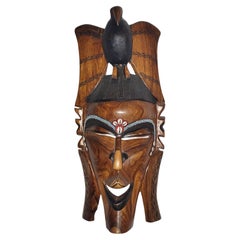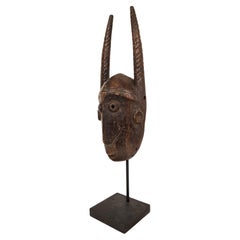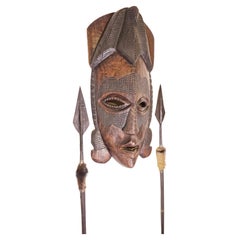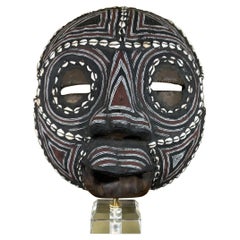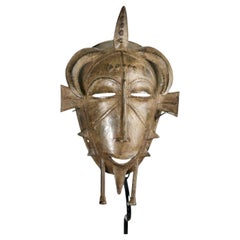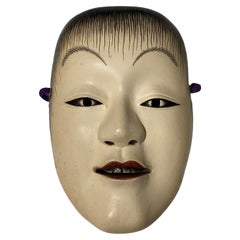Masks
1990s African Folk Art Masks
Wood
1950s Congolese Tribal Vintage Masks
Hardwood
1990s Cameroonian Tribal Masks
Brass
1970s African Tribal Vintage Masks
Shell, Wood, Beads
Mid-20th Century Ivorian Tribal Masks
Metal, Bronze
Mid-20th Century Japanese Showa Masks
Wood
18th Century Japanese Edo Antique Masks
Wood, Lacquer, Paint
Early 20th Century Liberian Tribal Masks
Wood
1960s German Folk Art Vintage Masks
Wood
1950s Mexican Folk Art Vintage Masks
Wood, Paint
20th Century Italian Folk Art Masks
Gold, Brass, Metallic Thread
Mid-20th Century Canadian Native American Masks
Wood
Late 20th Century Congolese Tribal Masks
Wood
20th Century Italian Masks
Composition
Early 20th Century Indonesian Other Masks
Wood
1970s Mexican Tribal Vintage Masks
Wood, Paint
1960s Mexican Folk Art Vintage Masks
Paper
Late 20th Century Malawian Tribal Masks
Wood
Early 2000s Masks
Brass
Mid-20th Century American Tribal Masks
Plaster
Early 20th Century Tribal Masks
Raffia, Hardwood
1970s Ivorian Tribal Vintage Masks
Iron
Mid-20th Century Japanese Showa Masks
Wood, Paint
20th Century French Mid-Century Modern Masks
Ceramic
1950s Mexican Folk Art Vintage Masks
Copper, Tin
1970s African Vintage Masks
Wood
Early 20th Century Nigerian Tribal Masks
Wood, Paint
1970s Mexican Folk Art Vintage Masks
Wood
Late 20th Century Malawian Tribal Masks
Wood
Mid-20th Century Congolese Tribal Masks
Wood, Paint
Early 20th Century Indonesian Other Masks
Wood
Mid-20th Century Japanese Showa Masks
Wood, Lacquer, Paint
Mid-20th Century Cameroonian Tribal Masks
Wood
1950s Congolese Tribal Vintage Masks
Hardwood
Mid-20th Century Japanese Showa Masks
Wood, Paint
Mid-20th Century Japanese Showa Masks
Wood
1950s Angolan Tribal Vintage Masks
Hardwood
Mid-20th Century Ivorian Tribal Masks
Wood
1970s Mexican Folk Art Vintage Masks
Paint, Plastic
Mid-20th Century Ivorian Tribal Masks
Wood, Paint
1970s Mexican Folk Art Vintage Masks
Fabric
20th Century Chinese Qing Masks
Wood
1970s African Vintage Masks
Wood
20th Century Papua New Guinean Tribal Masks
Wood, Paint
1970s Indonesian Other Vintage Masks
Teak
Mid-20th Century Japanese Showa Masks
Wood, Paint
1940s Mexican Tribal Vintage Masks
Wood
20th Century Japanese Showa Masks
Wood
Early 20th Century Unknown Tribal Masks
Wood
1960s Mexican Folk Art Vintage Masks
Paper
20th Century Ghanaian Masks
Wood, Paint
1620s Congolese Tribal Antique Masks
Animal Skin, Organic Material, Wood
Early 1900s Japanese Victorian Antique Masks
Gesso, Wood
1930s Japanese Vintage Masks
Leather, Fabric, Rope, Wood
Late 19th Century Japanese Meiji Antique Masks
Wood
1960s Mexican Folk Art Vintage Masks
Paper
Mid-20th Century Papua New Guinean Primitive Masks
Shell, Natural Fiber, Wood
1960s French Vintage Masks
Ceramic
Late 20th Century Folk Art Masks
Terracotta
1940s Mexican Folk Art Vintage Masks
Wood
Antique and Vintage Masks
Today, art enthusiasts and venturesome interior designers find a lot to love and appreciate about antique and vintage masks, particularly as they have earned a distinct place amid a collection of folk art and other collectibles and curiosities in contemporary homes.
Folk art refers to art that people, not classically trained, created for either utilitarian or decorative purposes. With respect to visual art in folk art, it is typically reflective of a community’s culture and usually handmade by craftspeople working within a popular tradition. Masks, as part of this history, have been used in carnivals, theater, medicine, therapy, religion and more. The use of masks in rituals and sacred ceremonies goes back thousands of years, and masks in general are believed to be much older. And all kinds of other uses have been found for masks and face coverings over time. We have enlisted these accessories for protection, to signal modesty, facilitate flirtation, enable licentiousness or simply to look cool.
Archaeologists found a mask in Palestine that is believed to be 9,000 years old, a Neolithic-era stone mask that may have been part of rituals associated with the worship of ancestors. Some tribal masks are worn as an offering to the gods. Masks are among the most important African art forms, for example, and traditional African masks can be used to lend a concrete form to an invisible spirit. Dancers donning wooden tribal masks celebrate important events to honor their deceased ancestors. These masks are also very important devices for storytelling and sharing the oral history of a community.
For Asian artists, specific colors are used in masks to convey different values and ideas. In Japan, a red Oni mask worn by performers during a festival might signify anger, while in China’s Peking Opera, a mask that has been hand-painted gold would be worn by an immortal.
Mexican craftspeople make masks for traditional celebrations and ceremonial dances. Mexican masks are part of the country’s folk-art traditions that go back thousands of years and play a role in festivals and theater. A common symbol of the Mexican holiday Day of the Dead is a skull, which is widely represented in masks (although the innumerable activities associated with the holiday are by no means universal).
We’re inviting you to explore and pay respect to the long folk-art traditions that underpin mask-making by introducing antique and vintage masks to your space. Find an exciting collection on 1stDibs today.
